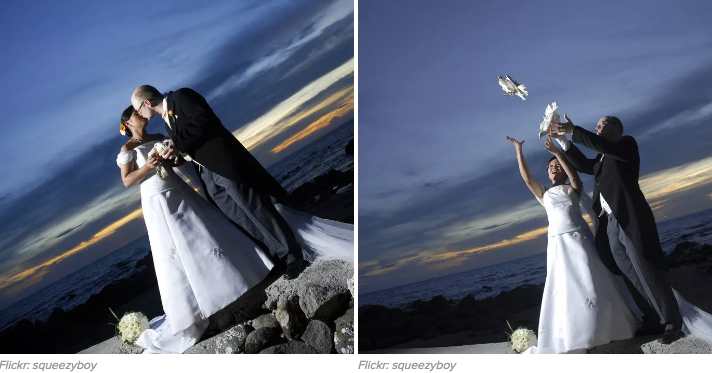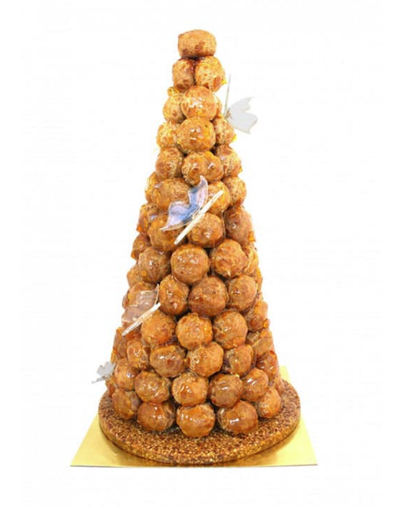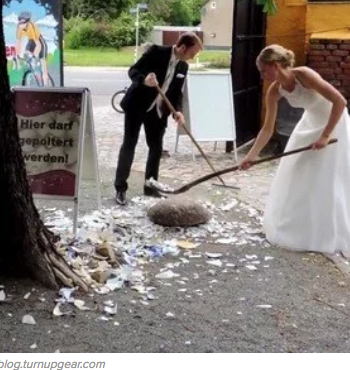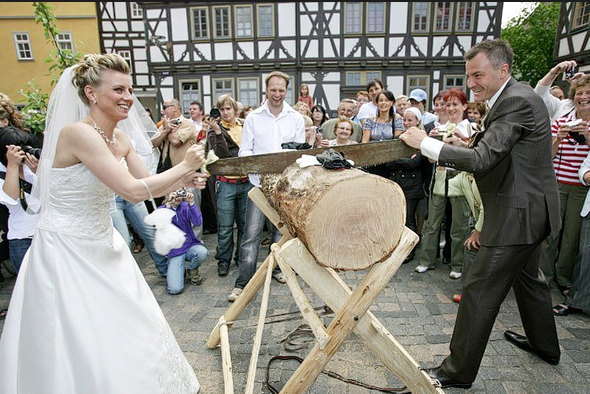|
At BT, we love the "Once Upon a Time" of wedding traditions and have been sharing some of the significance and origins of various "things we do when we get married." Today, with all do respect to the legendary, per se, we're sharing the things we do that extend beyond our current cultures and shores. So, gather up your mini flags from all nations and start waving them. Let's begin with Southeast Asia. In the Philippines, couples release doves as a visual wish for a long, harmonious and peaceful life together. That one has made it to the states and elsewhere in the world for sure. They are beautiful and flight brings its own metaphors of new adventure and beginnings. And from the sublime to the ridiculous ..... in Scotland, there is a tradition called "blackening." Couples are taken out the day before their wedding ceremony, given lots of alcohol and then covered with grease, flour, feathers, dirt, and only the Lord knows what else until they are filthy. Centuries ago, criminals were tortured and killed this way - it was called tar and feathering, because hot tar was used. Now, this ceremony is a fun way to ward off evil spirits before the union. .... and one may assume it wards off hugging others as well. And with that appetizing image, let's move to food, especially sweets. In a previous blog, we discussed traditional food, where the wedding cake is mostly featured. In French culture, they love a towering dessert (below, left) made up of small round, cream-filled pastries, known as a croquembouche. Couples and their guests may remove the treats and then dip them into a variety of yummy sauces. In Italy, confetti (right) doesn't mean teeny scraps of paper thrown at celebrations, but actually candies that are given to guests. I suppose you could throw these at the bride and groom as they leave for their honeymoon, but that could also lead to small claims court. How about work? Weddings bring their own kind of exhaustion, which is mostly emotional and mental: "Gotta stand and sit and dance and stand and sit and shake hands and hug and hug and hug." "Gotta remember vows, timing, details, names of your parents friends from four moves ago." "Gotta keep up with who has been seen, who needs to sit where, who doesn't like red meat, who doesn't like your Aunt LouLou and maybe remember a speech or two." Well, sports fans: in Germany, family and friends of the couple break dishes and glass outside of the homes of the bride and groom to greet them the morning of their wedding. From this "night before" wreck grew the traditions of hen and stag parties (our bachelor and bachelorette parties). As far as our researchers at BT could determine, this practice mostly signifies revelry or poor manners, but it does bring the couple together in a first project: clean up! These Germans are FOR REAL with their work/wedding scenarios. The second tradition worth noting in German ceremonies is when the newlyweds are asked - not long after saying "I do" mind you - to saw a log in half to show their ability to complete a task together. We have to say, like the photo above of dish clean-up, seeing a bride in her gown and up-do, sawing makes for a great juxtaposition. We'll end in South Africa with a list of items that symbolize a challenge the newly married will need to conquer troubles in life. The traditional South African wedding, incorporates 12 symbolic items into the ceremony: salt, pepper, wheat, wine, bitter herbs, a holy book, a broom, a spear, a spoon, honey, a shield and a pot.
Not bad, especially if they get to keep each item. You can never have too many spears. All kidding aside, we see more and more brides hoping to include items and gestures that hark back to their heritage. We would love to hear if you've included something atypical in your ceremony or are planning to!
0 Comments
Your comment will be posted after it is approved.
Leave a Reply. |
Archives
July 2024
|







 RSS Feed
RSS Feed
